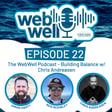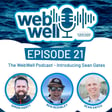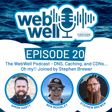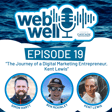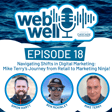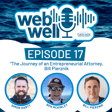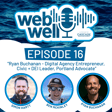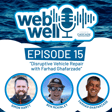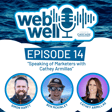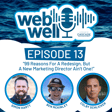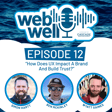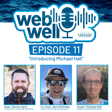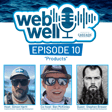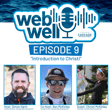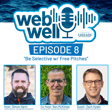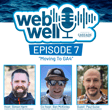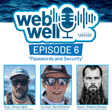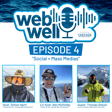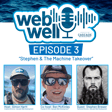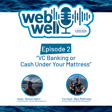Introduction to Web Well Podcast
00:00:06
Speaker
Welcome to the Web Well podcast brought to you by Cascade Web Development. I'm one of your hosts, Simon, along with Ben. And we can't wait to dive into all things internet, tech, web development, and web design.
00:00:20
Speaker
We'll also be discussing how we balance work and life and exploring the fascinating world of internet innovation. So whether you're a tech enthusiast or just looking for some entertainment, join us on this exciting journey as we explore the ever-changing landscape of the web. Thanks for tuning in and let's get started.
Cascade's Creative Services with Stephanie Murphy
00:00:39
Speaker
Excellent. Well, welcome listeners to episode number five of the Web Well Podcast. This is brought to you by Cascade Web Development. We're changing things up a little bit today. I'll be leading the conversation, given the topic is really focused more today on the expanded creative services here at Cascade last couple of years with the addition of Simon Hart. Our special guest today is Stephanie Murphy. Stephanie and I have worked together in almost all capacities. We started off where she was a client of Cascade.
00:01:09
Speaker
with her during her time at a previous employer. After that, she went to work for another creative services agency and we partnered on a number of projects. And then she even managed marketing services here at Cascade for quite some time, I think like a year and a half. Most importantly, for purposes of today's podcast, she introduced us to
Stephanie's Career Journey
00:01:29
Speaker
Simon. So Stephanie, welcome to the podcast.
00:01:32
Speaker
Thanks guys, thanks for having me. I'm excited to help out with the podcast and share my story of how Simon ended up getting on the train. Yeah, well, it's been great just in the last couple of minutes just to have this group back together. So why don't we start off, Stephanie, with you just sharing a little bit about your background and involvement with Cascade and how you came to work with Simon and think he might be a good fit for Cascade. Sure.
00:01:59
Speaker
Well, my originally early career, I was an ad agency person through and through. That lasted for about 15 years until I crossed over to the client side. And then I ended up going back to the agency world. And that's when I first met you, Ben. We had partnered before the agency I was working for had an in-house web team. Cascade was pretty much their partner, their go-to partner. And so we had partnered on several projects.
00:02:29
Speaker
And then I ended up getting a job at a software firm and ended up hiring Bends. I ended up hiring Cascade. And Simon and I worked together. We met through a
Simon's Transition to Cascade
00:02:42
Speaker
merger that happened while we were both at the software company.
00:02:45
Speaker
and so Simon and I had a great working relationship and we were both let go at the same time within a good 15 minutes of each other and I had the great fortune of introducing him to you Ben and you guys hit it off and it makes me so happy to to obviously
00:03:06
Speaker
provide Cascade with a great resource in Simon, but then also on a personal level to see Simon's career kind of take off in the direction that he really wanted it to go. And I think at Cascade, Simon, you've really found a home where you can grow and contribute and make an impact on customers' outcomes. So to me, this is like the happiest networking story on the planet.
00:03:29
Speaker
Yeah, fantastic. Well, thank you, Stephanie. Simon, why don't you tell the audience a little bit more about your background and both before and after life here at Cascade? Yeah. So I guess a real synopsis version of it after high school, I ended up going and becoming a bike mechanic, so working on bicycles. So I went
00:03:53
Speaker
down to Ashland, Oregon, uh, to United Bicyclons to got my mechanic certificate or whatever, and came back up to Seattle in, in the Seattle area and, and walked into a bike shop and got a job that day, uh, started the following morning.
00:04:08
Speaker
So it worked out really well. That career, I think, is just an awesome career in the bike shop retail space. I learned so much just about how to work and talk with people in sales, both as a mechanic as well as in sales. So long story short, worked my way up, ended up managing a couple of shops and decided after I got married that I really kind of needed to change my career path and do something that would be a little more lasting.
Simon's Career Path Before Cascade
00:04:36
Speaker
just shy of owning or starting my own shop, I would have topped out at management level. So I decided, went back and got my graphic design degree and then also added in some social media marketing certificates to that, which led me to my first job at a software company here in Spokane where I did in-house design stuff. And again, going back to bike shops,
00:05:01
Speaker
We had to wear different hats and one of my sweet spots, I guess, was design. So even back then I was designing out stupid little like sale tags, right? I would start with that. Started doing our advertising in print. So in papers, I would design out those ads. You know, and I had, I think I had like a physical copy of Photoshop and Illustrator back when that existed. It was like CS2 or something like that.
00:05:32
Speaker
Cost me an arm and a leg when I bought it. It was like $1,200, but it was worthwhile. Uh, cause that started kind of the trajectory I was headed, you know? So again, fast forward software company. I was doing in-house marketing for them. Uh, I managed about 500 or so.
00:05:48
Speaker
social media accounts for our clients. That was one of our products. And then really discovered I liked just doing in-house marketing, in-house design. Started doing that for that company. And then just from some, I guess, life experience there, I wanted to go back to bike shops just to get out of that business for a minute. Uh, did that went back. Uh, friend of mine, uh, had a shop that he just bought and needed it managed. So I went there.
00:06:16
Speaker
which again brought me back into software. So I ended up doing some part-time work, freelance work for another person I was familiar with and he invited me to come in full-time. That business ended up getting bought by the company that Stephanie worked for. And so there was this merger kind of situation where I came in
00:06:39
Speaker
at the time was a brand manager. So really heavily focused on, on client experience, user experience. Uh, we had a couple of apps that we had built, um, managed the website again, did our internal marketing, uh, started doing some video marketing and video production, uh, for that company as well. And then partnered up, like Stephanie said, uh, got to join her team, which was just she and I.
00:07:04
Speaker
So she and I for this whole team, all me and the mouse in my pocket, which she and I, like she mentioned, I think we just, we had a great working relationship where she, she did the talking, uh, and I just supported her and, and the teams that we as marketing, I guess would, would have supported.
00:07:27
Speaker
In addition to also the original company, I was still more heavily involved on that side when it came to supporting clients on some of the software that we had, as well as design work, both website and whatnot.
00:07:41
Speaker
And then like she mentioned, uh, within 15 minutes, I remember it was a Thursday cause I was headed out on vacation that, that weekend had some PTO time. So I was actually off. I got a call, uh, from Stephanie letting me know what was going down, what she thought was going down. And, and then I got a call soon after that call, which was my turn, same kind of conversation. And so that was, uh, the way we headed out on vacation to the San Juan islands.
00:08:08
Speaker
And then just again, like she's talking about, uh, just ended up connecting with you, Ben, uh, over the phone. Uh, I remember exactly we were on a hike, uh, headed out to the water. Uh, and I was like, no, I'm going to take this call. Like, I know I'm on vacation, but I need a job. So it just, it really timing wise, it sounded like for cascade as well as myself.
00:08:33
Speaker
just talking about the right time, right place, but also the right puzzle piece, the right shape. Not only was it the right timing, but it was certainly a good fit and became an even better fit as I grew into it, both for how we serve our clients as well as my skill set, adding that to the success and I'll say legacy that Cascade has for development.
00:08:58
Speaker
You know, again, I think we joke about it. I'm the newest employee of three years or going on three years. Like I'm still the new guy, right? Next newest guy is like 15 or 18 years, you know, and I'm coming in supporting as the new guy. I'm going to be the new guy for a long time, basically is what I concluded. But yes, definitely a pretty awesome fit for what I'd like to be doing.
00:09:22
Speaker
you know, finding fulfillment in my job, job quote. Um, I love it. Yeah. So it's definitely a good fit since then.
Balancing Personal Life with Career
00:09:30
Speaker
That's fantastic. I remember, uh, one of our, our early conference calls early in the pandemic and, and you were at your previous home and we were bantering back and forth and just seeing the way you guys interacted and how much fun you had.
00:09:44
Speaker
Uh, it was, it was really fun to just kind of witness and, and talk to us a little bit about your side hustle because it seems like you were just wrapping up that, that previous home. And then when you started here, embarking on a pretty significant, uh, project that you're, uh, you're sitting in now.
00:10:00
Speaker
I love you call it a side hustle. Like I needed a place to live side hustle. So I've never heard about building a house is a side hustle. Well, it seems like it's more than just one, right? Like you've, you've, you've moved, moved life forward in exciting ways through your, your willingness to roll up your sleeves and get after it.
00:10:19
Speaker
Well, I, you know, I, and again, I all attribute it all the way back to the bike shop. Like if there was something we needed done, we, we didn't have the income as a small business to go, we'd have the revenue to go hire someone, right? So if it was something I could do, I did it. And I think again, totally transitioning this into work, it's kind of that same model that I think I model or, or present, you know, cascade is like, I'm not suggesting we go hire someone to do it. I'm going to go teach myself. I'm going to go learn it so that we can do it.
00:10:49
Speaker
And if yes, if it's over my head, then we contract out. But I love taking ownership
Integration of Creative and Development Services
00:10:54
Speaker
of what I do. So man, timing wise, we had just started or finished remodeling a little house was let go. We had already purchased land, right? So we were in a land loan at the time and then secured
00:11:10
Speaker
basically the building plans that we wanted to build and then was let go. And normally, mind you, if you have a loan out there and you lose your job, you probably are going to lose your loan, right? Like it's just inevitable. I did some sweet talking.
00:11:27
Speaker
because the transition from what I was doing to what I started to do with Cascade was so identical that I basically was able to sweet talk saying, no, it's actually a promotion in the same kind of field. So they didn't actually stop the loan, which was super fantastic because soon after rates just skyrocketed, COVID really started to set in as reality.
00:11:55
Speaker
And so yes, so during COVID working from in-laws, I started with Cascade while building a home. And yes, we, we were acting more of a, as a GC. So there was other skilled professionals doing framing foundation, all that stuff, but we did a lot. Everything we could do, we did. So site prep paint. Yeah, a lot. So that's where I am now and, and have a nice space and it's quiet and sunshine coming in and.
00:12:25
Speaker
a background that's not blurred. Yeah. Fantastic. I was really impressed with how you, uh, navigated that, uh, somewhat tenuous time and then, and then balance those priorities through that first year where you had your hands full on, on a new job and, and, uh, you know, living, you know, living with your in-laws and building a new place. So.
00:12:45
Speaker
still excited to get up there someday and check that out. Well, wonderful. Well, I appreciate the background on some of those things from both of you. To get this, the topic of the day is going to be creative juices. So I thought what we might do is just invite Stephanie to talk a little bit about maybe some of the pros and cons she's seen over the years of, of including
00:13:06
Speaker
Are the pros and cons of having creative services as part of a development firm versus having those be you know exclusive for art for you know two firms and and trying to bring those those capabilities together you have any thoughts on that stephanie.
00:13:20
Speaker
Yeah, I think it's a great topic. And I think it's one that, you know, now that I'm on the client side, you know, firmly rooted on the client side, I have seen every version and hybrid of it in my time on this side of the fence. And I've also obviously been on the other side of the fence. I think that, you know,
00:13:40
Speaker
It all comes down to fit and what you're trying to accomplish what is the client what are your goals but i think you know having having the creative capability in house in house at the developer firm side.
00:13:56
Speaker
it closes it's a shorter walk to get to your end product where your creative can talk directly to the developers and they know they have that familiarity of shared language between a developer and creative where when you're working you're managing a creative firm plus a development firm
00:14:18
Speaker
You're a lot of times having to bridge that communication gap between the two and Unless you're someone like someone like myself who has been on You know working with cascade when I was consulting with their marketing So I understand the firm the structure of the firm and the people inside the firm But then also having worked on the client side, but I feel like I'm more of a rarity on the client side because I have such deep
00:14:48
Speaker
time on the other side, on the agency side. So I think that as long as I've known the team at Cascade, the addition of Simon beyond him being a fantastic person to work with and the fountain of creativity, I think having that service in-house is a huge bonus because when I was consulting with Cascade to help find new clients for you,
00:15:14
Speaker
you didn't have that tight like you had some go-to designers that you trusted and that you'd partnered with so you have that again shared language shared work style but it was still a longer a longer walk to the end of the project and so by having simon in there you know he can i know that he can turn around it's like you know a double play in baseball you know you can he's the the second baseman he can just turn it and whip it
00:15:42
Speaker
to first base. So I think just having that speed of development or speed of conversation
00:15:51
Speaker
is key and I don't think a lot of development firms have that or even want to have that because they they're firmly rooted in we are developers we are ux ui we are you know nothing wrong with that and if that's what you're looking for then that's great but I think you know if if you're a um a client looking for the right fit and if you don't have
00:16:17
Speaker
a solid go-to creative solution either on your own internal team which is usually not the case or if you don't have an outside agency that you love a door and trust explicitly then having creative and development under the same roof in your case the same train or virtual train now you know that it just it's just a much more efficient way to go and you know from a
00:16:45
Speaker
But the pros of when things go south, as much as everyone, we all on this call, all try to ensure that projects don't go south and we've all got our head on a swivel. It's like, what could possibly go wrong here and try to head everything off? Having creative and dev in one place, it's one throat to choke when things go wrong. And so I think there's something to be said for that.
00:17:14
Speaker
I only have to be angry at one person as opposed to two different teams and then bring those two teams together and collectively explain where things went off the rails. Huge disclaimer, oftentimes when things go off the rails, it's because of the client. I'm not putting blame on the agency people by any stretch because again, I've been on both sides. I've been that throat that has been choked multiple times.
00:17:39
Speaker
I just think from an efficiency standpoint, you're going to get more efficiency of scale paying one firm than paying two firms. From a brand understanding standpoint,
00:17:54
Speaker
you're explaining everything to one team of people. And, you know, like the software company I work for right now, we have four products, but we joke that they all kind of have, you know, they're all intricate and they all have their little asterisk after them. And it's a lot for any freelancers that we bring in or consultants that we bring in or anyone else that we bring in from the outside. There's a lot of like, oh, but yeah, here's the product. But then there's this, this and this you need to pay attention to.
00:18:24
Speaker
So only having to explain that to one team and so that one team totally gets our language is a huge benefit. That's great.
Collaboration Benefits at Cascade
00:18:35
Speaker
Good perspective. Simon, what are your thoughts on that as you've worked now with our team alongside shoulder to shoulder with our developers and with me in service of our clients, even when in some cases we're actually leading on the creative side. Other cases, we're not.
00:18:51
Speaker
We just want to get as far down that path and show up very professionally in some of the areas that are perhaps a little less binary. Yeah. I think my position is very selfish. Like I want to be involved in every project only because I think that I can add from a, from a creative standpoint, so much value. So yeah. So for one projects that we lead, I mean, it's, it almost, I hate calling it like a secret weapon.
00:19:15
Speaker
But having dev and design have such a intimate relationship of just a close relationship where I can just ping them in Slack, get my response, get an answer, get some options to present to the client, and just to better inform my design work. I'm able to actually design ahead of time, hand that to dev, hey, can we do this? Is this possible? And I keep challenging them. I'm sure they love me coming in and pushing the envelope.
00:19:45
Speaker
Uh, I just feel like it ends up being a better product, a better value for the client. And I, I mentioned this to you, Ben, when we were talking about this topic of like, I was on a screen share with a client, we were just kind of QA'ing an issue she was having or, or problem solving kind of like, this is the content, what, what modules blocks, how could I present this? What are my options? And.
00:20:06
Speaker
And so we just did it on the screen. I was doing, I said, well, we could do it this way, this way. And we just came to the conclusion that we just needed to modify one little thing to make this kind of repurpose, if you will, a module. So I happened to be at the time sharing my whole screen. So she saw Slack come up. I chatted with Michael and presented kind of what we're looking at. And he goes, give me one second. So she and I ended up talking about something else for probably two minutes. And then his response was done. I took care of it.
00:20:36
Speaker
And so I refreshed my screen and showed her and she just goes, what? Like that is amazing, right? The, the service there. And, and it kind of hit me at that moment. Like normally if you wanted something like that done, we're talking about some turnaround time. Like there's emails, I've got to send it to the developer. I've got to explain what it is. I've got to wait until they check it, right? They're working on other projects right now.
00:21:02
Speaker
Don't get me wrong, I know I totally interrupted Michael, whatever he was doing, so it's based on his availability, but he was there, right? And more often than not, he's there. Or Paul or Stefan when I need some help. Just having that intimacy for me as a designer gives me a lot of confidence that I can present some pretty cool stuff without having to do those meetings where I've done it with other partners where
00:21:29
Speaker
We have to actually go through all the design, make sure it's feasible. Then they come back to me 24, 72 hours later, a week later. I mean, if they're in the middle of other projects, it's time, right? And I think like Stephanie is saying, just the speed. And I love the baseball reference. You know, if I'm on second or short, you know, I could throw and get it to first so much faster, you know, I think than having multiple teams elsewhere.
00:21:57
Speaker
And the extra secret weapon is that I know Evergreen, our CMS platform. I know it really well. So not only do I have a perspective, as I said, new guy, I have a client's perspective of Evergreen versus Michael and Paul and Stefan that built the thing.
00:22:18
Speaker
I'm able to present to them a user experience that is very, very much similar to our clients. Not only can I design for it, I can design around it and with it more efficiently, more effectively, and then communicate that with my team and then communicate back to me so much faster. I called it a secret weapon. I don't want it a secret. It's not a secret, it shouldn't be a secret, but it's such a value.
00:22:45
Speaker
And I think that scenario that you outlined, Simon, where you're on the phone with your customer,
Enhancing Client Projects through Creative Services
00:22:52
Speaker
and I know that you can't be designed on the fly. Everything's done in two minutes. But that demonstrates that short walk that I was talking about between idea and change.
00:23:07
Speaker
And and you know what i like and i think something that's kind of lost in you know our coded world of everyone's remote now is that creative what if thing of. You know can we just sit down and like what if what if we do this can we do this is this possibly like a kind of rapid fire.
00:23:25
Speaker
I'm just trying to sort through a problem and let's do this together. And for you, you, Simon, is that point to be able to understand where the customer is coming from and what they're trying to get to, but then also understanding what's possible in Evergreen and what's possible with developers. But then you're also pushing the developers to say, is this possible? You know, I think that's a super valuable tool for Cascade to have. Yeah. I just think.
00:23:55
Speaker
And I also think kind of going back to the the pros of having an in-house, you know, creative at Cascade is even if you're working with a client that, you know, is a established brand with its own marketing team and a very in very specific brand guidelines. And so you're you become you're extrapolating the brand.
00:24:21
Speaker
you're not inventing a brand. They're not asking you to reinvent the wheel. They're asking you to build out the tailgate. But it needs to look like it's all the same car. And I think you, from a design standpoint, having worked with you, you can extrapolate. So you can kind of take it if it's from scratch,
00:24:42
Speaker
I need to develop the brand, the whole shenanigans of the brand voice and the style and all that kind of stuff. But it's more like, we've been around for 50 years. We need to build the website that looks like us. We don't need your spin on it, but you understand how to live and create inside brand guidelines, but then also add to it. In my agency life, we had a great fortune of working with some really talented
00:25:11
Speaker
Designers that could extrapolate and there's a lot to be said for that where you're not reinventing things, but you're you're like
00:25:19
Speaker
expanding on the client's brand, but then also enhancing it just a smidge more where it still feels the same, but it just looks a little bit cooler without violating any brand tenants, which I think is incredibly important, you know, as me serving as the logo police, brand police for my whole career. Right. You know, it's nice that when you can trust someone to
00:25:44
Speaker
to not go crazy with it, but just expand what's there. So I think with Simon on board at Cascade, you guys offer both that. If you need a new exploration of your brand voice, super. If you need your 50-year-old brand to just grow a little wider because you're adding whatever that is in a digital format, you can do that as well. Yeah, I like all of that.
00:26:16
Speaker
when it comes to that, like stewarding the brand, right? And that's something, I don't want to say I take sensitively or take for, I guess seriously, because the brand is those things that you can't feel touch, right? It's the things you feel inside. It's your perception of it, right? And so being able to be handed that, I feel like it's, to me, I get all emotional about it. Like I'm not going to cry or anything, but it's, it's an honor, you know, like yours, the thing you made.
00:26:37
Speaker
I like the word steward.
00:26:46
Speaker
you know, take care of it. And you and I, Simon, you and I have talked about that. Yeah, we've talked about it. It's like I get all protective of the brands that I am so fortunate to work on. And like they're little babies and I'm, I'm the brand steward. It's like, or like a campsite. It's like, we have this beautiful forest and it's ours to take care of and leave it better than you found it. And you know, I've moved on from so many brands in my career, but it's like, I always hope I made it a little bit better. And I hope the next person
00:27:15
Speaker
does it too and that's the thing that kills me is like when you see like a brand that you helped foster for however whatever period of time three five years ten years whatever you you you've helped it grow and you know just gain more followers and more people that love the brand as much as you do but then you see it get like
00:27:35
Speaker
manhandled and picked apart and like misguided, it's gone off the trail. And it's just like, my brand. Like I just recently suffering, suffering the loss of one of my favorite all time clients. Over the years since I stopped working on it, nothing to do with me, but the company was sold and now it was sold and now it's being completely dissolved. And
00:28:00
Speaker
It's a retail product and I still see some of their product on the shelves but I know that it's like the last inventory of it and it makes me really sad. I do get emotional about that type of thing.
00:28:13
Speaker
I'm not alone. Yeah. And I kind of look at those things. I look at those kinds of things too, where, you know, our developers are so good in their domain, but that only goes so far. And in fact, when we first started Cascade, it was Stefan and I, he designed and developed sites, but he would get, he would take, you know, customer feedback quite personally. And it's just like, he's so used to things being right or wrong that when he'd put design out and get critical feedback, he'd be like, no, that was right. They're wrong. And it's like,
00:28:42
Speaker
commission creative work. We can't really have that position. We go through that with partners over the years and now having Simon there where we have the trust. And so there's the trust and the knowledge, right? So we trust and know that we have a shared mission of serving this client.
00:28:59
Speaker
But we also know that he's got knowledge that our developers don't have. And so when it comes to those more subtle brand things, topics, considerations, Simon hears that he's tuned into it. He's bringing that forward versus putting something out that, hey, functionally checks the boxes. But from a brand, from an experience perspective, way missing the mark. And then all of a sudden we've rattled the confidence of the creative team. We've rattled the confidence of the client. And so I think those are some examples I've seen. The other example is one where
00:29:29
Speaker
you know, a creative person, you know, that's on contract, let's say might come in with a great idea, but it's like, it doesn't, it doesn't work in this environment. So, so you coming forward with the idea, getting the client really excited about it, and then us saying, Well, to pull that off is, you know, either really against best practices and just kind of this way out there creative idea that would probably frustrate more people than it would serve. Or
00:29:53
Speaker
that's not in line with what we've talked about in the budget and timeline constraints. You know, we're much more on the same page, just kind of chopping it up internally before we're presenting it. And I've seen that so many times where it takes two, three client engagements with a creative partner before we have the awareness and knowledge and trust of where, where we should go and where we shouldn't go before we review it internally, or excuse me, before we share it with a client. But so often, everyone's excited and like, look at this, look at this, what about this? And it's like,
00:30:21
Speaker
Ah, let's not get too far down that path because that isn't working over here. So I've certainly appreciated the heck out of Simon's contribution along those lines as he gets more familiar and isn't necessarily putting things forward that our developers look at and go, yeah, that's not reasonable. We can't do that. Yeah. And I think, you know, I always kind of joke because
00:30:43
Speaker
You know, both my role and Simon's role, we've been we've had to be the voice of reason because it's so easy to get caught up in a creative idea. You're like, oh, that's the coolest thing ever. But then.
00:30:55
Speaker
I and people like Simon get to step up me like it's either not on brand on strategy on budget on timeline and and now you know having Simon is that that connector between creative and development he knows enough to say that that is like physically unable to produce in a web format.
00:31:16
Speaker
Because for me, I'm very much on the non-web side of like, I come up with ideas and I don't know what's structurally physical, like what is structurally possible in a web environment. Because my career has largely been in print and packaging and retail. And so I think very much in a non-digital world, and sometimes I get ideas that are just like, that is, yeah, it's possible.
00:31:46
Speaker
but it's not functional and it's just like Ben, to your point, it's just gonna cause headaches for the user. But yeah, I think, you know, Simon is very much of the voice of reason. And when he and I worked together, when our job was challenging, he was my voice of reason. I kind of don't think I should ever be the voice of reason. And if I'm the last stop on the reason train, like it's really reconsider your goals in life.
00:32:17
Speaker
Well, that's great. I guess what I'd like to do right now too, and this is something that's been somewhat challenging for me over the years, is what are we talking about when we say creative services? So Simon, maybe you could talk a little bit about how we break that down, how we think about that. And that might just be some good sort of learning and language for listeners of the podcast to consume and think about as well.
00:32:41
Speaker
And I think that would be helpful for me, too, just because I think creative services, the idea of creative services has shifted over over the years. And so, yeah, I think. I think that would be great to explain. To the listeners, I think that's great.
00:33:00
Speaker
Yeah, I like the term. It can kind of be a two-edged sword in a way because it's very not specific, right? It's just creative services. It's just out there. You know, I think ultimately it comes down to a couple of parts. One,
00:33:17
Speaker
if we're talking about actual physical assets or not physical digital assets, creating the actual design, creating the video, the video production, the animation, creating those files, those assets.
00:33:34
Speaker
And I know we're a web development, but even if it was a startup and we needed to do business cards, right? Then I'll bring your wife into this. She is starting a new venture and needed a logo. She needed colors. She needed a business card, right? People still do that, like print out business cards, you know?
00:33:54
Speaker
So there is that side of it, but I almost want to rewind all the way to the very beginning of any conversation when it comes to a company's image, right? So we're talking about brand, brand identity, brand strategy.
00:34:09
Speaker
So there are physical assets that are part of that, but also even to the naming of a business, naming of a product to its appearance. And again, because it's such a broad statement, we're also talking about like a project. You know, it doesn't have to be the start of a company. Ben, you had mentioned a client having an in-house design team, but wanted to like,
00:34:37
Speaker
come up with some ideas. They, they were either drawing blanks or didn't have any ideas or direction on an idea concept. And so they involved me, they brought me in where I was able to ask all these, these kind of third party questions, meaning like, have you thought of this? Have you thought of this, right? And they're able to say, yes, we thought of that. Okay, perfect. What about this, right? They ended up, it was,
00:34:59
Speaker
for a beer company, a client of ours. And we had this idea that they loved, they liked the idea and we were able to actually develop it. So Michael, the developer at the time was on that call. So being able to be creative, I didn't build any of the assets.
00:35:15
Speaker
I did however repurpose them. So the design elements were already created. I was able to take those and kind of translate them if you will, right? I used those to create new ones, handed it off to Michael and Michael could do his thing. So that is, it's kind of a Swiss army knife in the realm of digital creation, right? So creative
00:35:41
Speaker
A creative is definitely the thought process from start to finish to end up with a product, end up with an asset, end up with some direction. And again, our involvement could be full, we could literally do everything you need, or it can just be a complementary kind of relationship where
00:36:00
Speaker
you built the asset and I helped modify, I helped translate, I helped steward. Again, going back to that word where I can help maintain that. Another client of ours needed to, I think we called it whiz, was it whiz bang? No, that was another one. We had these terms, right? I think
00:36:20
Speaker
Yeah. So we basically needed to spruce up a homepage and we wanted to do something. She's like very specific. I want to do something here. And so basically coming out with that idea, pitching the idea, pitching the concepts from the beginning.
00:36:38
Speaker
And really it's being able to, Stephanie, like you said, basically put me in that brand's shoes and think about what would benefit them or communicate best to their audience. And that is something that's so fun and intriguing to me, which is why I love what I do, is I get to sit there and be the client for a second, think of that as my business, think about who I'm trying to communicate to and solve it, right? It's constant problem solving.
00:37:08
Speaker
in a creative space. So I know my answer was, was pretty wide or, or vague, but it, it, it encompasses every little step within there, uh, or even some of the steps. It doesn't have to be all of them. Right. I don't know if that answered it. Yeah. Yeah, I know. That's great. No, I think so. And you had provided an outline as we prepared for this, that I think also would be helpful in terms of where the rubber meets the road.
00:37:32
Speaker
Uh, and, and it's fascinating to look at because I'm working with, you know, a couple of clients now where they are, they do have a creative team and, and I understand that subject matter expertise is unique within these domains, but my gosh, they have different people for every role and these feel like pretty narrow roles. And, and again, from an efficiency perspective, I think sometimes that can be challenging, especially if you're somewhat budget constrained, but
00:37:57
Speaker
To sort of break this down into topics that some of our listeners might resonate with and grab onto, I think specifically these include things like graphic design, web design for sure, and under that, that might include UI, UX, so the user interface design as well as the user experience and sort of the steps they take and the
00:38:21
Speaker
sort of that non-design element, but the elements that are behind the design, if you will. Certainly the quality assurance process, once something gets built, going through those steps and saying, how does it actually function now that we've digitized this vision that we all came up with together?
00:38:38
Speaker
uh, you know, in a more static environment, uh, branding and identity. Um, Simon talked about that quite a bit. So that's designing logos, packaging, marketing materials, like the business cards, um, creative direction or consulting. I think that was a great example of the, the beer client where we were coming up with more like the kernel of the idea and, and the, you know, the way in which people are interacting with the brand.
00:39:00
Speaker
but then handing over the design process to an in-house designer, handing over the development to a developer here on our staff.
00:39:09
Speaker
video post-production, animation, those are things that, that we're now able to provide. And a number of clients have, have enjoyed working with us on that front. And then I think as, uh, as Simon had mentioned before as well, this notion of internal consultation and rapid delivery. So when we are talking to a client, he's able to grab onto certain elements and really drive that conversation forward while interacting with our developers.
00:39:33
Speaker
And it's really just that mind hive where we're bringing our best to the table because we have different perspectives on a topic versus narrower perspective sets that then just limit how far and wide we can push a conversation. What you touched on with the mind hive idea
00:40:05
Speaker
have Simon serve as both the both the voice of the customer, the client and the understanding of the developers and what's possible, you know, and and speeding that along and understanding that, you know, that example you gave of like, oh, it was fixed in two minutes isn't the norm, but it's the pace. Like, for example, this is kind of more in a in a in the in the regular world. But when I was at a former
00:40:22
Speaker
of just being able to
00:40:33
Speaker
former job as we were building a trade show. And I had initially worked with a company that was very formal and that had, you know, if I wanted to make an edit, it was talk to my account manager. He'd go back and talk to the CAD people. Four days later, they'd come back with, oh, here's that corner treatment you wanted to talk about. And then I would say, well, I want to change this radius. And then it would be three more days to come back.
00:41:03
Speaker
with another sketch and so it was this like walk through the valley of death to get this thing developed and then we switched trade show companies and it was a 180 where we went to Vegas where the booth was being built off-site and stood there with a construction team
00:41:27
Speaker
rapid building display cases on the fly out of plywood. And we could say, no, we want to tweak this. No, we want this an inch shorter. No, we want this an inch. So it was that version of what you described, Simon. And the project went fast. It was super creative. It was more creative than all of that back and forth and back and forth and back and forth.
00:41:48
Speaker
And it gives a project more energy when you can see those kind of rapid changes and improvements, or even if it's the idea of the change, of knowing that it's possible, still gives it that energy that you want in all your projects. We're barreling forward because everybody wants things done super fast.
00:42:09
Speaker
right and and even if super fast means three days or a week, but there's that energy behind it because you're iterating along the way and improving and Collectively that mind hive sharing. Everyone's bringing something a little different to the energy of the project So I think that's something that you guys have in spades now with Simon on board
00:42:34
Speaker
Well, and I, and I appreciate all of that. And I, and, and what I hear and take from that also is just that notion of it's like, it's like improv, right? It's, it's the yes and approach to that conversation where it feels like oftentimes when you have a variety of different teams or, you know,
00:42:51
Speaker
contributors within a team that don't know and have as much trust, it can be a yes-but or a no-but. And that's just like, well, that's just, that's kind of not that fun. But if we as a team can work through that in a yes-and manner and just be like, yes, because we're, we can predict what the other person's recommending, and there aren't these recommendations that are way out there from capabilities or, you know, it being a rational suggestion.
00:43:16
Speaker
it just kind of continues to refine and get narrower and narrower toward that, that end goal versus I find a lot of times conversations, they feel more like discovery sessions. Cause it's like, Oh, you're thinking that, well, we're not really ready to respond to that yet because we just need to kind of get our ducks in a row and, and come back in a way that's respectful versus, you know, having to like shut someone down. And that's what we find sometimes in the technical perspective is all the creative ideas get elevated and we're like,
00:43:43
Speaker
great, but, you know, here are the challenges behind your brilliant idea. And that's not a fun message to send where, you know, when we're working as a tighter team, I feel like there's so much awareness that there are fewer opportunities where someone has to respond with a no or, you know, a but it's just yes and let's keep going and riffing on this thing and coming up with something really cool rapidly.
00:44:07
Speaker
And I also think, you know, working with a small team from the client side when, you know, and I've been fortunate to be on both sides of that conversation, but when you develop the relationship, like what I had when I was on the client side working with Cascade or working me on the client side, working with other agencies, you can, there's kind of like no holds barred as far as like creative ideas. You're like, you can actually tell the client like,
00:44:33
Speaker
with no insult of like, it's not gonna fly and here's why, as opposed to like wording an email of saying, well, that's interesting. And here are the restrictions to the budget where you can just say not or they can say like, they can say to you like, oh, that's a ridiculous idea. But I appreciate where you're going. And so like, when you when you have again, that creative energy is flying,
00:44:56
Speaker
Everybody's involved.
Successful Creative Projects and Networking
00:44:57
Speaker
There's no person, you know, like the whole, like no bad ideas thing. And but truly to be able to have a relationship. And that's what I had with cascade. You could, you could throw out anything and either have it be, yeah, that's a good idea. Oh no, that's ridiculous. And it's like, okay, well then let's move on. Cause we're moving. Ultimately we're all moving towards the same goal and you guys get my goal and everything else. If it's a fun idea, but if it doesn't fly, then let's move.
00:45:24
Speaker
And I just think that's the kind of energy that I think everyone who works even in a tangential connection to creative development, especially in a digital setting, is looking for, is that energy and speed and endless creative thinking toward your goals. And it doesn't have to be creative in the sense of like, oh, we're going to do skywriting, like huge creative, but if it's creative that is goal oriented.
00:45:53
Speaker
Right. I work in software. I work in CRM and business intelligence software. We're not like doing super splashy stuff. We're selling software to distributors, which is super interesting, but it's not like flashy. That's not what they want. They want intelligence and you know, in that, but there's still excitement to be had in that realm. So I think that applies whether you're selling beer or wine or
00:46:22
Speaker
any other cool clients that you guys have. I think if you can create that environment that fosters creative ideas and is backed up with an energy to execute quickly and with that same creative problem solving, I think it's like gold. It's outstanding.
00:46:40
Speaker
Yeah. And I think one of the things I've loved more than anything about, you know, Simon's addition to the team and the skills he brings is just all of a sudden we can go back to our existing clients and say, Hey, we've got some things to offer. We didn't used to offer. What are your needs? And I think one thing we're definitely seeing in the last several years is, you know, workforces within organizations are being reduced.
00:47:00
Speaker
And so then all of a sudden some of the stuff that maybe they wouldn't have talked to us about, even if we had the capabilities, all of a sudden it's like, Oh, you guys do that? Wow. That could really solve a problem for us. And yeah. So I want you to talk a little bit about some of the opportunities that you see out there in the future that get you most excited as we, as we continue down this path and continue to find really cool opportunities that help you continue to flex those creative capabilities on top of the highly valuable and critical project management work that you do.
00:47:29
Speaker
Well, we'll go ahead and name drop then too because I think it'll make way more sense when we talk about what clients we were doing this for or past clients we had worked with.
00:47:39
Speaker
both redesigning stale sites, like I love coming in and like, where do you see this? What could we optimize? How could we change this? And it could be a full like clean house redesign, but often that's not the case. It's not that it needs a full redesign. It's that there's some opportunities that are missing or again,
00:48:00
Speaker
The internet changes every day. The priorities back five years ago on a site are different than they are now. Your clients have changed. How they visit your site has changed. They're not all on a desktop now. I know that's like beating a dead horse talking about a responsive website, but that experience has also changed. It's not just that it had to resize. It's that all of that change.
00:48:27
Speaker
I love that. I love the idea, like you said, Ben, of supporting as a designer, as an in-house designer. McAdam Forbes is a client of ours. They're a commercial real estate agency in the Portland area.
00:48:44
Speaker
And I love working with Cindy. She will just spit out her idea and it's her terms, right? Like she's almost apologetic about how she gives it to me or delivers it, but she's like, that's the best way I know how to say it. And I think one of my strong suits and one of the problem solving skills I love is taking that and understanding what she meant and offering and delivering something that actually executes the objective really well.
00:49:14
Speaker
So that was one client that specifically she would just give me, like, Simon, this is the best I know how to say it, and deliver, right? That is something that I think a lot of clients may have. Go ahead. And I can attest to that, Simon, when you and I work together, I know on more than one occasion, you being in Spokane and me being in Portland, that I've scribbled a comp on my notebook and held it up to the Zoom camera and be like, I want it to look like this. And it's just like Sharpie, scribble, scribble, scribble, and then like,
00:49:44
Speaker
an hour later i get a compact and it you know so yeah you have that unique skill to be able to uh speak that english to or what is it uh client to you know client to agency language of like oh i get you like that would make no sense to regular people but i get you
00:50:05
Speaker
Yeah, right. And and I think that that bridging that gap, I think some people have some fear of like, I just don't know how to speak. So I'm not going to ask. Right. And I would challenge that and say, no, just puke it out. Speak it. Tell me sketch it on a napkin or a notebook. Send me that screenshot. Send me that photo. Give me what you got. You know, and I can make something from it. And so I think the idea of of like Ben was saying staffing wise,
00:50:32
Speaker
consider us an in-house design firm. Just consider me your guy. I think that relationship and trust goes a long way where a client can send me that. I can produce something and I know
00:50:48
Speaker
that it will work, you know, and trust that I'm mindful of all of the scenarios, all of the client facing kind of objectives, budget, timeline, their clients and all that. I also think of another one, Buff USA, they did these face masks, neck gator kind of things, heavy and like outdoor, obviously outdoor arena.
00:51:13
Speaker
This role, they had a super strong marketing team. They knew what they need to do, super efficient, super effective in details. They knew their numbers, where people clicked, what people were clicking on, and they had an objective and they just wanted to
00:51:29
Speaker
an additional opinion. And on most of these calls that I'm being introduced to, and Ben Ben probably attest to this, I don't say much. I don't need to say much at the beginning because I'm just being that sponge. I'm just absorbing. I'm listening to everything they're saying because I'm trying to be caught up in a way, right? Like I'm trying to catch up to where we're at.
00:51:51
Speaker
And then finally, it's kind of like, all right, Simon, like I remember Ben, if you remember that call, it was, I mean, it was a year and a half ago or so, like with drew at buff. All right, Simon, you haven't said much talk, right? Something to that effect. And I was able to come in and really just help support what he was seeing and invalidate some of, I think some of his, his.
00:52:14
Speaker
impressions that he didn't say yet. He didn't say them on the call yet. And so it gave him confidence into the decision-making that he needed to make. Like, we need more people getting from this screen to the sales screen, right? Like, how do we do that? And so I, you know, presented some options. And I just remember him saying,
00:52:36
Speaker
Yep. Yep. That's what I was thinking, but it just, I hadn't said it and I needed some another voice. Right. Um, and so I, I love being able to be that way. Yeah.
00:52:48
Speaker
Yeah. So yeah, I would say, you know, from redesigning stale sites to even just acting as a consulting role coming in and really optimizing UI, UX, the way things are looking, the whole experience oftentimes isn't a full, you know, scrapping of the site. Sometimes it's just a modification. Yeah. Other times are full. Don't start from scratch, you know, so.
00:53:14
Speaker
Well, unfortunately we've got some backend tools that allow us to take some of those measured steps instead of blowing it up and starting over. And I think that's one of the things that I always like to remind our clients of is boy, even if we haven't touched it in a while, it doesn't mean that it's beyond repair. You know, the last thing we want to do is, is, you know, throw the proverbial baby out with the bathwater. It's like, let's, let's take care of the problems. Let's optimize. And I think that's led to a lot of our audit services and just keeping these sites future proofed. So having that, that involvement there has been great.
00:53:43
Speaker
Yeah, because I can, you know, I can tell you from the client side, nobody wants to blow up their site and start over. That's, you know, in a lot of cases, it's a career killer, like I've seen co workers lose their jobs because websites didn't go well. And, right. And, you know,
00:54:01
Speaker
And oftentimes what I see is when someone new comes on in the marketing capacity, it's like, Oh, well I've got to make my mark by creating a new website. So that creates some, some transition challenges that we often face where it's like, Hey, you know, let's, let's get to know each other and understand what your needs are. But boy, yeah, I think we can, we can really make you look good, save money and be much faster. If we work together to, to bring your vision to life versus everyone knows a web guy and then bringing that person and blowing everything up. And then to your point, there's a lot of risk there for the,
00:54:30
Speaker
that subject matter expert in that organization to take that lead. And, you know, I think for your existing clients, you know, there's a reason why your platform is called Evergreen because you can add to it. And that's like a shameless plug that I just came up with. But, you know, you can add to it so you don't so you don't need to blow it up.
00:54:51
Speaker
Because I've been involved in every iteration of that and blowing up a site is not fun and it's not easy and it's not cheap. There's no shame in making updates. I do think when you get a newer person, they want to put their stamp on the website.
00:55:16
Speaker
I think from the client side and being in the corporate world, the people above you as the marketing person would rather have you put your stamp on the EBITDA of the company rather than a shiny website if the website is still delivering. Invest $50,000 in getting more sales and fewer abandoned carts
00:55:41
Speaker
that's gonna win you a lot more points and get you a bonus more than, oh, look, we've got some new influencer on the front page of our website. Can I spend everybody's bonuses on that new website? So you're welcome.
Conclusion and Call for Collaboration
00:55:56
Speaker
Well, this has been great, Stephanie. Boy, it sure is fun to have you come in and share your perspective on this topic and given your contribution to Cascade over the years and certainly with Simon. I'm curious, is there anything that maybe we missed that you feel like it would be a good topic to bring up on as we're chatting here? This has been super fun. I like the angle that you guys are taking with this podcast, spotlighting the talent. I still refer to it as on the train, even though it's virtual.
00:56:27
Speaker
I just think, you know, you guys are a small and mighty team. And like I said, at the top of the top of the event, you know, this relationship between Simon and Cascade and myself and Cascade and Simon is like the greatest networking story I've ever been involved in. You know, my mission in life is to make sure that my friends are happy and that if I can help foster someone's career path, as I've had great mentors in my career,
00:56:56
Speaker
you know, it just makes me really happy to see that it's not only, you know, that Simon has landed somewhere good where he's growing, it's also helping one of my favorite companies grow. So it's kind of like the best of both worlds. So I'm just happy to be here. Fantastic. That makes three of us. Simon, was there anything else that you want to touch on before we let everyone get back to it? Well, I guess a full on shameless plug.
00:57:23
Speaker
Give me some more design work, clients. I'm here for that. I want to help support that. You had slightly alluded to our audit services of allowing time to review that stuff. I'm going to use another analogy, but using it as a garden. I know there are farming methods where you just let it sit and it just does its thing.
00:57:53
Speaker
I'm still one of those were like you have a given soil let's tell this thing let's let's fertilize it let's make it better we're not talking about throwing the dirt out we're talking about just optimizing what's there and I think design. Constantly is changing users are constantly changing technology is constantly changing like why wouldn't you sell. That would be my shameless plug to a.
00:58:17
Speaker
Yeah, give me give me some time so I can look at your site and make it better. That's a great place to end. Well, I want to thank both of you for joining me today on the podcast. Thank everybody who's listening in here. As we've all been conditioned, we'd love any kind of review or liking of the podcast sharing that with others as we get off the ground here and excited to continue to to provide good content and share our thoughts along the way.
00:58:44
Speaker
Well, thanks, guys. Thanks for having me. Yeah. We'll catch up with you again soon. All right. Bye bye. Bye.

